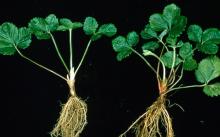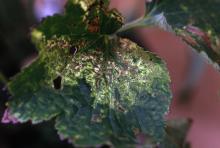See:
Strawberry Cultivar Susceptibility
Cause Cultivars of strawberry that have become important in the PNW are tolerant to infection with multiple aphid-transmitted viruses, except Hood. Strawberry crinkle virus, strawberry mottle virus, strawberry mild yellow-edge virus, and strawberry vein-banding virus commonly infect strawberry plants in the Pacific Northwest. These viruses are transmitted by the common strawberry aphid, Chaetosiphon fragaefolii. Tomato ringspot virus (TRsV) is spread by the dagger nematode, Xiphinema americanum, and related species. Tobacco streak virus and pallidosis disease also are in Pacific Northwest strawberry fields. Strawberry pallidosis associated virus is whitefly transmitted.
More than 30 viruses and virus-like diseases have been reported in strawberry. Before bringing plants into the Pacific Northwest from other areas, be aware of the viruses in those areas. New virus problems could be inadvertently introduced and cause major losses.
Symptoms There are few if any diagnostic symptoms of specific viruses in our common Northwest cultivars. Some general symptoms are described below.
TRsV-stunting and sometimes death. Susceptible Pacific Northwest cultivars are Benton, Hood, Olympus, Puget Beauty, Rainier, Shuksan, and Totem. 'Northwest' appears to be immune.
Aphid-transmitted viruses-vigor and yield decrease, but usually the only distinctive symptoms are dwarfing, leaf cupping, and yellowing. The cultivars Totem, Shuswap, and Sumas are the most virus tolerant; Hood is the most sensitive. The former cultivars become infected as readily as others but usually do not show symptoms unless infected by three of the viruses.
Tobacco streak virus-loss of vigor and yield without distinctive symptoms.
Pallidosis-symptoms are not severe alone but pallidosis increases the severity of many aphid-transmitted viruses when they infect a plant at the same time. Stunted plant growth, purple or red coloration of older leaves and brittle roots. Leaves eventually dry out and plants die. New leaves may look okay as they develop at times when the virus titer is not high.
Cultural control
- Use planting stock that is certified as tested and free of all known viruses.
- Do not set out new plants next to old, virus-infected fields.
- Use cultivars that are tolerant to viruses.
- Control known insect vectors. Aphid flights peak in late April to early May and again in September-the most critical periods for controlling aphid vectors. See the PNW Insect Management Handbook for details.
Reference Martin, R.R. and Tzanetakis, I.E. 2013. High risk strawberry viruses by region in the United States and Canada: Implications for certification, nurseries, and fruit production. Plant Disease 97:1358-1362.



